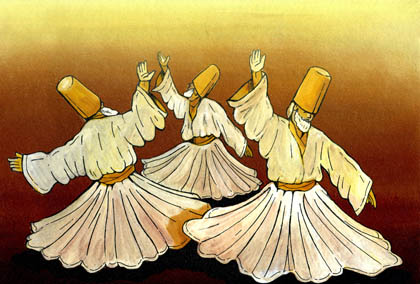SUFI MEDITATION DEFINED
A Path To Divine Healing
Essential to the progress of the follower of a shaykh towards the rending of veils and victory over this illusionary world is consistent and daily Sufi Meditation .
Sufi Meditation is synonymous with the technical Sufi term which translates to “Noble Connection” and has always been a central practice of Islamic spirituality—Sufism. This science of contemplation is the subject of an entire section in the works of Imam Ghazzali (q), and it has always been a core practice of the Masters of the Naqshbandi Order. Sufi Meditation may also be seen as synonymous with the more general practice of meditation that is so central to many of the Eastern spiritual traditions, the goal of which has always been the fusion of the individual back into the oneness of the Universal Reality.
The default condition of mankind is immersion in the illusion of this world.
For the uninitiated, that illusion is reality—the material world of the senses is all that exists. However, as we progress along the path of spiritual development, our understanding of reality changes. We learn that this world is completely unreal. We come to understand that there is another reality—an authentic reality—behind this realm of illusion, a reality from which we are veiled, but which, nonetheless, is the only reality that really matters to us.
Once we reach this level of understanding, once we come to accept the illusory nature of the world around us and begin to discern the reality that lies behind it, we begin searching for a doorway through which we can pass out of this realm of delusion into the realm of realities. Sufi Meditation is that doorway.
Through Sufi Meditation, we detach ourselves from this false world and immerse ourselves in reality. Only by cutting ourselves off from the unending onslaught of the senses, by tuning out the distractions of this world, can we hope to escape from its tyranny and oppression.
We must recognize that there is no special reward for doing what is required. If we perform the daily prayers, pay the poor-tax, fast , and make the pilgramages, we will only have done what our Lord commanded—thereby, God-willing ensuring our salvation in the next life. But there is no trophy for completing these basic requirements. There is no trophy for fleeing from a burning building—the one who escapes the fire by virtue of that fact alone. If we want greater rewards than that we must look farther. Those who want to reach higher stations must work harder.
Endless treasures await those who strive towards their Lord, but each treasure has its key that must be unearthed. Performing supererogatory devotions, praying extra prayers, and making remembrance of God and recitation of His Names and recitations of prayers (all such remembrance and recitation is referred to under the general Sufi term of “remembrance” or dhikr) are all keys that unlock such secrets. But the most important key, the one that unlocks the door to the Divine Presence, is Sufi Meditation.
All prophets came to their peoples urging them to see beyond this world to the heavenly plane beyond this life. But we cannot enter into this new world without leaving the old one behind. First, we must extricate ourselves from the tangled web of ego and attachments that binds us here. This act of extrication is referred to as “negation.” When we manage to negate ourselves, when we manage to die before we die, then we enter fully into the world of realities.
Sufi Meditation is the first step on this path of self-negation. The practice of Sufi Meditation has no rational explanation in the terms of this world, because in its essence it is a negation of this world. It is based on spiritual rather than material principles—chief among being the existence of two types of sight which function simultaneously in each person.

Principles of Sight
One form of sight is limited and requires a medium in which to function. The other is unlimited, functioning independently of any medium.
The medium within which the first form of sight functions is physical space. This form of seeing can only perceive that which exists in the dimensions of physical space. Even within those dimensions, it is extremely limited. For example, it can only detect that which reflects or emits wavelengths of light within a narrow band of the electromagnetic spectrum.
It cannot perceive very small objects without the aid of special mechanical or electronic aids. It can only encompass objects with an unobstructed line to the person who sees. This mode of seeing also relies on physical action of the eyes to transmit the images they perceive onto the screen of the mind.
The other form of seeing is free of such limitations, and functions on the plane of heavenly realities. The images it apprehends are projected directly onto the screen of the mind without the intervention of external organs. It is this mode of sight that functions during Sufi Meditation.

Seeing one’s spiritual guide
by means of this second form of sight. It is the seeker’s attempt to concentrate his thoughts on the screen of the mind, liberating his perceptions from physical limitations. The more frequently he is able to project a thought form upon that mental screen, the more vividly that mental pattern will be realized within the mind. That is why maintaining consistency is so important with this practice, and indeed with all spiritual practices.
Sufi Meditation may then be seen as a mental approach whose ultimate goal is to allow the seeker to travel from this world of illusion to the Divine Presence. When we visualize our spiritual mentor, the knowledge of the Divine Attributes that operate through him is reflected back upon our minds. With frequent repetition, the mind of the follower reaches the level of enlightenment, acquires the ability to communicate directly with the Mentor, and acquires spiritual awareness of the Mentor. In the science of Sufism, this state is referred to as the station of Affinity. Attuning oneself with someone more pious than ourselves.
The best and most reliable way of enjoying this affinity is through the longing passion of love for the Mentor. By maintaining the practice of Sufi Meditation, the mind of the Mentor continues to transfer knowledge and understanding to the mind & Heart of the follower, according to the intensity or degree of this love. As this love grows and the bond of Sufi Meditation intensifies, the Divine Lights operating in and through the Mentor—which are, in fact, reflections of the Beatific Vision of Allah are transferred to the follower. This enables him to become familiar with the Lights of the Divine Presence, so that he can experience the Beatific Vision and open the doorway within his heart to the Presence of Allah / God / The Divine Presence. In Sufism, this state is referred to as the station of “Becoming One with the Mentor.”
These Lights and this Vision of the Divine Presence are not personal traits of the Mentor. Just as the follower is able to experience these Divine Realities through his spiritual connection with the Mentor, the Mentor experiences them through his spiritual connection with the Holy Prophet [s]. The Mentor, in his turn, absorbed the knowledge and attributes of the Prophet [s] through the same devoted attention and concentration. In the language of Sufism, this state of affinity between the Mentor and the Prophet [s] is referred to as the station of “Oneness with the Holy Prophet.” And it is through this spiritual union with the Prophet [s] that the Mentor is able to share his abilities with the follower.
In the state of “Oneness with the Holy Prophet,[s]” the follower is gradually consumed by love, passion, and longing for the Prophet [s] until, step-by-step, he assimilates and apprehends the knowledge of the Prophet [s]. At that auspicious moment, the knowledge and learning of the Prophet [s] is transferred to the seeker in accordance with his capacity. He also absorbs the traits and attributes of the Holy Prophet [s], again each according to his capacity, aptitude, and ability.
From this exalted state, the follower continues to progress by developing his affinity with the Prophet [s]. Ultimately, he reaches the point of being able to truly and authentically acknowledge the Lordship of Allah recognizing God as the Lord of All the Worlds with full comprehension and acceptance of the meaning of that Lordship. At this point, he declares, “Yes, indeed, You are our Lord God!” This is the station of affinity with Allah ¹, and is referred to in Sufism as the state of “Oneness with Allah,” or simply “Oneness.”
Where the follower goes from this station—if he is granted the ability to reach it and continue beyond—is beyond the power of words to narrate or explain, for it is a realm of spiritual subtlety that cannot be described.


